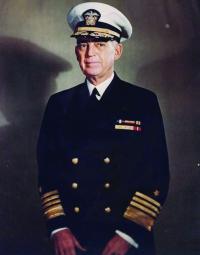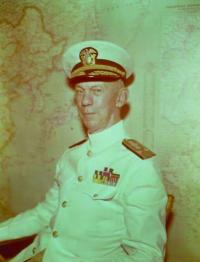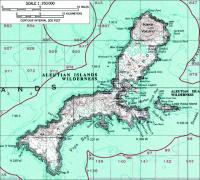
Thomas C. Kinkaid

Rear-Admiral Charles Horatio McMorris

USS Indianapolis

Kiska Map
Seventy years ago, American Forces embarked on a naval, air, and land operation to recapture Kiska and Attu Islands from the Japanese. These two islands lie at the tip of the Aleutians Islands Chain which extends for 1,200 miles southwest of Alaska, and were occupied by the Japanese in 1942, following the Battle of Midway. The goal of this operation was to reestablish full control over the Aleutians and expel the Japanese from North American territory. The U.S. war strategy in the Pacific at the time was based on a thrust into Japanese held islands in the Central Pacific, and advance along the shortest route to the Japanese Home Islands. To guarantee success for such a gigantic drive, the northern flank had to be secured. Thus, the full control of the Aleutians Chain by the U.S. Forces was considered a prerequisite before any advance into the Central Pacific.
The Japanese had captured these islands during, and as part of, the operation which resulted in their defeat at Midway in 1942.
For the rest of 1942, and early 1943, the Japanese tried to keep these isolated island garrisons supplied. This process was difficult and dangerous. On February 18, 1943, the U.S. heavy cruiser Indianapolis caught and sank the Akagane Maru, an unescorted cargo ship bound for Attu Island. The Japanese determined their next reinforcements to the Aleutians would get through. For a convoy of only three vessels they assembled an escort consisting of practically the entire 5th Fleet, Northern Force: two heavy cruisers, two light cruisers and five destroyers.
In March 1943, the U.S. Naval Forces in the area received radio intelligence indicating the Japanese would be pushing more cargo ships through to Attu. They established a scouting line of one heavy cruiser, one light cruiser and four destroyers west of Attu. This force, commanded by Rear-Admiral Charles H. McMorris, found and engaged the Japanese force on the morning of 26 March, 180 miles west of Attu and a hundred miles south of the Russian Komandorski Islands. Known as the Battle of Komandorski Islands, the two forces opened fire at long range. The battle lasted for several hours. The U.S. heavy cruiser Salt Lake City was heavily damaged at one point, but was able to withdraw at slow speed guarded by the accompanying destroyers. Instead of pressing his advantage in firepower, and fearing that he might lose his supply ships, Vice-Admiral Hosogaya, decided to disengage and went back to Japan. His superiors in Tokyo would not take any of this. With such overwhelming firepower he should have prevailed easily, but he did not. For his failure, Vice-Admiral Hosogaya would never command a naval force again.
On 11 May 1943, U.S. forces under Admiral Thomas Kinkaid began their invasion of Attu Island. Admiral Kinkaid, commander of Northern Pacific Force, assembled an imposing armada to support the invasion. In addition to a bombardment force of three old battleships, an escort aircraft carrier, and seven destroyers for escorting and providing fire support for the Army landing force, he had two covering groups, composed of several cruisers, destroyers, and submarines, to guard against any possible challenge by the Japanese Northern Area Fleet. Reinforcing the naval support, the Eleventh Air Force was to provide 54 bombers and 128 fighters for the operation, holding back a third of the bomber force for use against ships of the Japanese fleet.
The landings on Attu were tough. Troops of the 7th Infantry Division were hampered by cold winds and fanatic Japanese resistance. The end came on the night of 29 May when most of the surviving Japanese, about 700 to 1,000 strong, charged madly through American lines, screaming, killing, and being killed. The next day the enemy announced the loss of Attu, as American units cleared out surviving enemy pockets. Although mopping-up operations continued for several days, organized resistance ended with the wild charge of 29 May, and Attu was once more in American hands.
For the invasion of Kiska, Admiral Kinkaid sought to ensure that the final assault in the Aleutians would be made with better-equipped and more seasoned soldiers. His assault troops would wear clothing and footwear better suited for the cold weather, and the landing force would consist of veterans from Attu.
A U.S. intelligence estimate of enemy strength on Kiska was about 10,000 men. Admiral Kinkaid arranged for his ground commander, Maj. Gen. Charles H. Corlett, U.S. Army, to receive 34,426 troops, including 5,500 Canadians, and elements of the "DevilÙs Brigade."
Unlike Attu, Kiska was subjected to a heavy pre-invasion bombardment. But in the end, the Allies had attacked an uninhabited island. The entire enemy garrison of 5,183 men had slipped away unseen. To make the embarrassment complete, the Kiska evacuation had been carried out on 28 July, almost three weeks before the Allied landing. On 24 August 1943, General Corlett declared the island secure, marking the end of the Aleutian Islands Campaign.
In the end the Japanese lost 4,350 killed, 28 captured seven warships sunk, and nine cargo transports sunk. For the Allies, 1,481 were killed, 640 missing, 3,416 wounded, and eight captured. In addition 225 aircraft were destroyed, and one destroyer and two submarines were sunk.
The centerpiece of the campaign was the battle for Attu. In terms of numbers engaged, Attu ranks as one of the most costly assaults in the Pacific. For every 100 enemy found on the island, about 71 Americans were killed or wounded. The relative cost of taking Attu was thus second only to Iwo Jima.
In one sense the departure of the Japanese from Kiska without a fight was unfortunate. It gave U.S. commanders a false picture of what might be expected from the enemy when the odds were hopelessly against him. Instead of fighting to the death, as in Attu, he had faded into the fog without a struggle. But Attu, not Kiska, was to provide the pattern of future battles against the Japanese.
NEXT WEEK: DEATH MATCH
«Go back to the previous page.